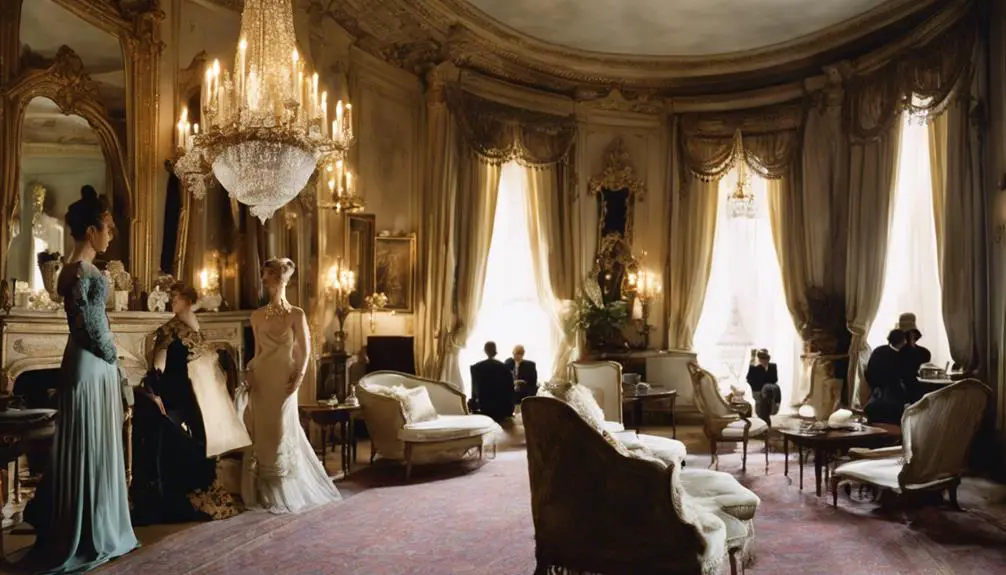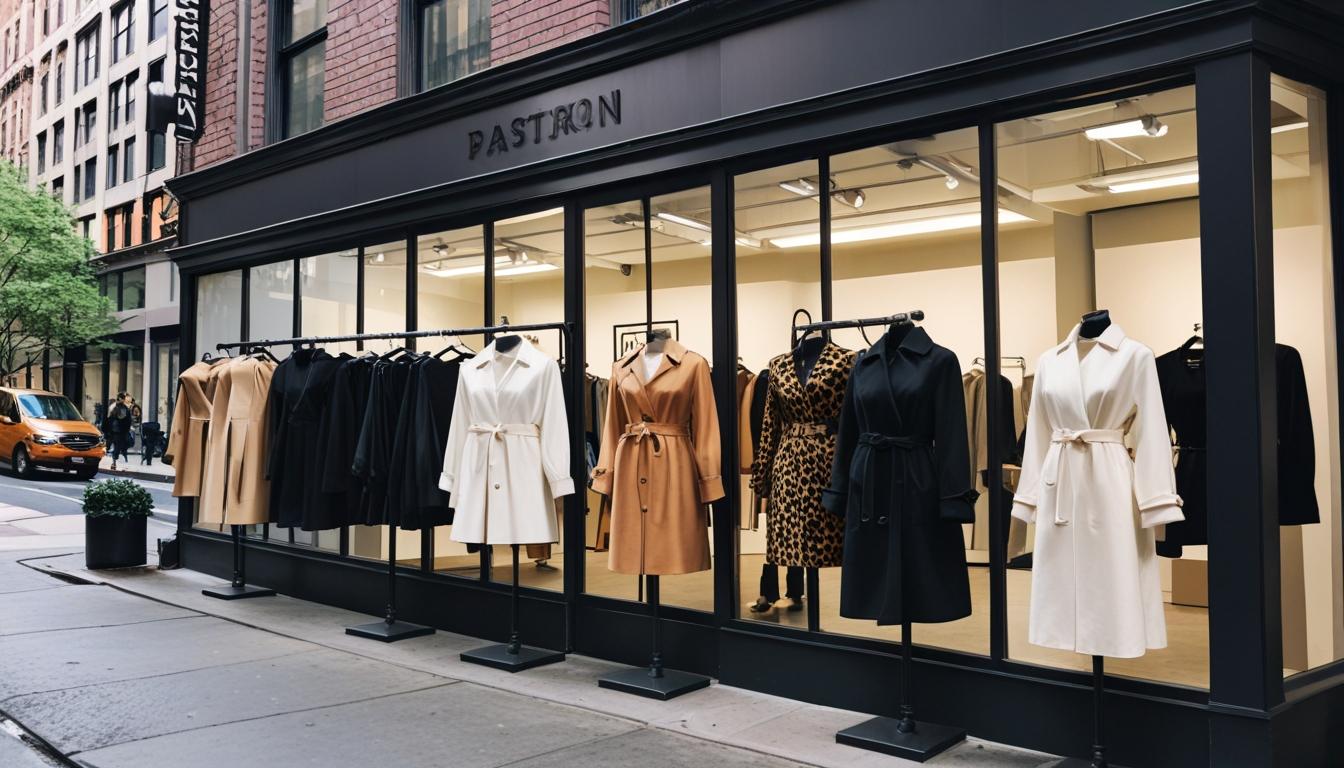The House of Lanvin is renowned for its iconic designs, particularly the Robe de Style created by Jeanne Lanvin. This dress, known for its dropped waist and full skirts, transformed women's fashion in the 1920s, blending comfort with elegance. Lanvin's masterful use of vibrant colors and intricate embellishments—like beading and bows—reflects her artistic vision and craftsmanship. She also pioneered the concept of mother-daughter fashion, promoting strong familial bonds. Today, Lanvin continues to inspire with its legacy of creativity and empowerment. You'll find that many contemporary designers have been influenced by her innovative spirit and unique style.
Jeanne Lanvin's Vision

What drove Jeanne Lanvin to transform from a milliner into one of the most influential clothing designers of her time? It all began with her love for her daughter, Marguerite. Jeanne wanted to create custom gowns that would make Marguerite shine, and this passion fueled her shift into the world of women's fashion.
Her innovative approach led to the creation of the iconic Robe de Style, a silhouette that combined a dropped waist and wide skirts, inspired by the elegant dresses of the 18th century. This design not only provided comfort but also flattered various body types, making it a favorite among many women.
Recognized as a master colorist, Jeanne infused her creations with vibrant colors drawn from fine art and her travels. Each garment was a canvas, showcasing her keen eye for detail and intricate embellishments.
Her vision didn't stop at women's fashion; the House of Lanvin expanded to include menswear, lingerie, and even household goods, establishing a diverse brand by the 1920s.
Jeanne Lanvin's legacy is one of creativity and passion, marked by her playful yet serious engagement with design. Her influence continues to inspire contemporary fashion, reminding us of her innovative spirit.
As you explore the greatest designs of the House of Lanvin, you'll see how Jeanne's vision not only transformed her life but also left a lasting impact on fashion history.
Iconic Design Elements
Iconic design elements of the House of Lanvin reflect Jeanne Lanvin's unique blend of artistry and innovation. At the heart of her creations is the Robe de Style, a signature silhouette that features a dropped waist and wide skirts. This design not only flatters all body types but also offers comfort, making it a timeless favorite.
Lanvin's use of intricate embellishments—think bows, beading, and rich colors—showcases her exceptional craftsmanship as a master colorist, creating garments that are visually stunning.
Jeanne's designs embody a playful spirit, emphasizing femininity and modernity. She understood the pulse of youth culture, mixing nostalgia with contemporary influences to set trends that resonate with many. Each piece serves as a canvas for artistic expression, brimming with innovative motifs and decorative elements that convey cultural significance.
The craftsmanship behind Lanvin's creations is marked by exceptional attention to detail. You can see it in every stitch and every bead, ensuring that each garment isn't just fashionable but also a unique work of art.
The emotional connection her designs forge with wearers speaks to their lasting appeal.
Historical Significance

Jeanne Lanvin's designs have left a profound mark on fashion history, particularly with her pioneering approach to mother-daughter fashion, which reshaped the industry. Founded in 1889, the House of Lanvin introduced the world to the concept of matching outfits for mothers and their daughters, a trend that not only catered to familial bonds but also influenced generations of designers.
Her most iconic creation, the Robe de Style, debuted in the 1920s, featuring an ankle-exposing bouffant skirt that transformed haute couture aesthetics. This design wasn't merely about style; it represented a shift towards a more playful and youthful expression in fashion. Vogue recognized Lanvin's impact by naming her one of the great women of the world in 1927, highlighting her innovative contributions that resonated with youth culture.
Lanvin's artistic influences are evident in pieces like the sulphur-green dress "Symphonie," where she seamlessly blended fine art and historical references. This ability to incorporate artistry into her designs set the stage for the evolution of modern fashion.
Moreover, her commitment to craftsmanship and design helped pave the way for women's empowerment in the fashion industry.
Today, Lanvin's legacy continues to inspire contemporary fashion, as designers draw from her classic styles and innovative spirit. You can see her influence in modern collections, proving that Jeanne Lanvin's vision wasn't just a moment in time; it's a lasting impact that continues to shape the world of fashion.
Cultural Influence
In the domain of fashion, few designers have influenced cultural perceptions as profoundly as those from the House of Lanvin. Jeanne Lanvin's innovative creations, particularly the Robe de Style, blended traditional aesthetics with modern elements, redefining the very essence of haute couture. Her work didn't just reflect the trends of her time; it actively shaped them, altering how society viewed femininity and youth.
Lanvin's emphasis on mother-daughter dressing established a significant cultural context, promoting the idea that fashion could strengthen familial bonds. This trend resonated with many, making it a cherished concept that continues to inspire designers today.
Her intricate embellishments and vibrant use of color captivated youth culture, illustrating how fashion can serve as a storytelling medium. By embracing these themes, she crafted garments that empowered women, allowing them to express their identities in a rapidly changing world.
The legacy of the House of Lanvin endures, as contemporary designers draw inspiration from her pioneering spirit and artistic vision. Modern interpretations of her classic styles echo the innovative essence that Lanvin instilled into fashion.
This connection between past and present underscores her lasting cultural influence, reminding us that the garments we wear can embody more than just aesthetics—they can reflect our values and relationships.
In celebrating Lanvin's contributions, we uncover how her designs not only transformed the fashion landscape but also enriched the cultural narrative around femininity and youth, leaving an indelible mark on the industry.
Legacy and Modern Impact

The legacy of the House of Lanvin continues to resonate in today's fashion landscape, where its innovative designs and emphasis on femininity inspire a new generation of creators. Founded by Jeanne Lanvin in 1889, the brand established a pioneering approach to haute couture that focused on comfort and elegance. The iconic silhouette of the Robe de Style, popularized in the 1920s, remains a hallmark of this vision, appealing to women of all body types.
Lanvin's commitment to craftsmanship and attention to detail hasn't just shaped fashion history; it's also kept the brand relevant in modern times. Contemporary designers often draw from Lanvin's rich heritage, incorporating its innovative designs into their own collections. This blend of tradition and modernity allows Lanvin to maintain its influence, even as fashion evolves.
Moreover, the cultural impact of Lanvin can't be overlooked. The brand has played a significant role in shaping perceptions of femininity and youth in fashion. By paving the way for future female designers, Lanvin transformed the narrative around women's roles in the industry.
Artistic partnerships throughout its history further reinforce Lanvin's status as a key player in both historical and modern contexts. Collaborations with artists have highlighted the seamless connection between art and fashion, ensuring that the House of Lanvin remains an essential part of today's creative dialogue.
As you explore Lanvin's legacy, you'll see how its enduring impact continues to inspire and shape the future of fashion.



